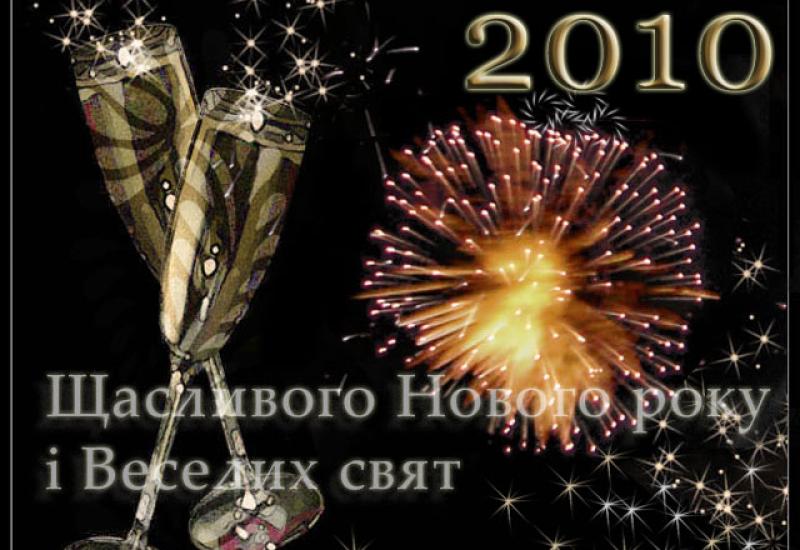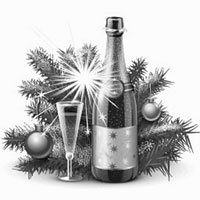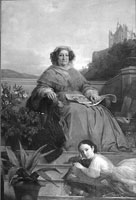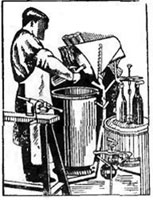The New Year is coming, with the scent of Christmas trees, ornaments on the windows, glare, bright colored balloons and garlands. We really want this holiday to be magical and unforgettable. Firstly we should choose champagne, because without this seductive nectar the celebration of New Year is impossible. This is one of the "alive" drinks, that is a symbol of our hopes for happiness and good luck. In New Year's Eve its indomitable character will make us forget about everyday life and more light-hearted. What secrets does the wine of kings and king of wines hide?
About Champagne
A French province of Champagne, which is a situated miles east of Paris, owes its glory our gastronomic pleasure. But that was not always. Champagne is known in Europe since the twelfth century. At that time the earls of Champagne were becoming reach not because of the vineyards, but because of the road. The province was situated at the crossroads of trade routes and the tradesmen from all over the continent visited the famous Champagne fairs. And a powerful earl family was established. Farmers, the main inhabitants of the province, had to seek new income. And they, with the help of the monks found them. In truth, champagne wine would be fairer to call “Marn wine“ because the best vineyards, which are the raw material for the production of champagne is grown in Marns department.
House of Perynyon
A long time ago the winemakers noticed that the wine begins to ferment in barrels and foams in the first days of spring. Only at the end of the XVII century they realized that it was the carbon dioxide formation, which was a by-product of fermentation. The Benedictine monk from Oville Pierre Perynyon abbey noticed this phenomena and he is said to be an inventor of so-called secondary fermentation method.
It is believed that while watching at the wines and after making a lot of experiments, don (from the Latin. Domus - «master», the reference to the cleric in France) Perynyon taught champagne to foam correctly. The main point of the method was in adding to the wine some sugar and in the following excerpt drink in thick-walled bottles; sugar begins to ferment and a created carbon dioxide becomes dissolved in wine. A brilliant idea to pick and mix the wine from grapes that was taken from different vineyards belongs to Perynyon. He also thought about blinding of the bottles, he suggested to use cork stoppers (the same were already used by the British) instead of the archaic pieces of cloth or oiled wood plugs attached to the neck of the bottle with rope. And finally, the monk offered to drink champagne with a narrow elongated glasses to enjoy the golden sparkling drink with soft foam.
Doubts
However, the role of Pierre Perynyon as the inventor of Champagne method is often questioned. Foam drinks were already created by ancient Romans, and the French monk only used the existing recipes. Some totally deny the existence of Perynyon, considering him as a fictional character, also his birth and death dates are similar to dates of the Sun King Louis XIV (1638-1715).
Even in Bible it is written about sparkling wines. The "foaming wines" are mentioned in the works of Homer and Virgil, Shota Rustaveli, Omar Khayyam and many other authors. Near Don the Greek settlers did sparkling wine at the beginning of our era. Even in south France, in Lim, people started to make sparkling at the beginning of the XVI century, while in the Champagne they began to produce the wine only in the beginning of XVIII century. The peak of champagne popularity was in the end of XIX - early XX centuries. During this period Strauss wrote an opera dedicated to champagne, and people danced at balls polka named "Champagne".
About its name
The name "Champagne" gained historical and commercial value only in the twentieth century, it led to a protracted war because of this "brand" ownership. The French started demanding that only the drinks which were made by classic champagne technology (champagnized) with wine grown in the historical Champagne region were named "champagne". The French offered to call other wines which belong to the same group "sparkling" and "produced according to champagne technology". According to the Law of Ukraine "About the grapes and grape wine" we should distinguish champagne, sparkling wine and carbonated wine. Champagne is a sparkling white champanized three-year aging in bottles wine made with the use of sucrose.
Sparkling wine is product obtained by primary or secondary alcoholic fermentation of fresh grapes, grape must or wine. In carbonated wine a foamy property is acquired as a result of artificial saturation of carbon dioxide.
Sparkling wines are divided into sweet (10% of sugar), semi-sweet (8% of sugar), demi-dry (5%), dry (0,8-2%), brut (0.3-1.5%). The experts believe that a true Champagne must contain very little amount of sugar and natural basis of the best grapes.
If there were no widow…
That is not a surprise that the wine merchants widows played quite a great role in champagne history. After inheriting the work of their deceased husbands, they began insistently earning the places for them among the entrepreneurs-men. Clicquot-Ponsarden widow, Laurent Perr'ye widow, Pommer widow, Enrio widow... Their names have become brands. In France these women are called "famous widows of champagne".
Nicole Ponsarden, aged 21, married Francois Clicquot. As it often happened, two families who owned vineyards united. In 6 years the woman became a widow. A young business-woman had an outstanding entrepreneurial talent and imagination, and she famed her husband’s name all over the world. She is also known as the inventor - she invented the stand-Reading-desk used by all manufacturers today. Madame Clicquot died at the age of 89. She left a trading house that bears her name and is loyal to tradition of impeccable quality. By the way, it is secondly ruled by a woman. People buy "The Widow Clicquot" in 150 countries.
Russian champagne
First sparkling wine was made in Russia in the middle of the XVII century by the residents of Cossack villages near Don: Kumshatska and Tsimlyanska villages. They did not know any French technology, they only used their own experience. At the times of Peter I the champagne appeared at court. French kings drink had the reputation of the most expansive and prestige wine in Saint Petersburg. The Russians celebrated their victory in Patriotic war in 1812 with French champagne and the victory in Second World War they celebrated with Tsimlyanskoe wine.
Prince L.S.Golіtsyn is believed to be the founder of "Russian champagne", he founded the sparkling wine bottle classic way production in his Crimean estate "New World" in 1878-1899 years. The last pressrun of worldly famous Golitsyno champagne was poured in 1905.
The best in the world
More than a hundred years the factory "New World", created by Leo Golitsyn, is he cradle not only of the Crimean but the Ukrainian winemaking.
In the early twentieth century, the Europeans associated Eastern Europe, including Russia, only with bears, dolls "matryoshkas" and frost. But Leo Golitsyn stubbornly worked to develop their own champagne. In 1900 he took his best sample of champagne "Paradyzio" to the international exhibition in Paris. Tasting Committee was composed of oenologists from around the world and it consisted from about 200 people. After the end of degustation, the drink-winner, which was awarded the Grand Prix, was treated to all present people in order that every winemaker could distinguish whether it is his wine. When the glasses were filled, Earl Sandon, who at that time was known as a famous winemaker and received several previous awards, being absolutely sure of another victory, stood up and said, "I raise this glass and praise the hands of people who made this wonderful drink - champagne!" but he was stopped by Leo Golitsyn who said, "Excuse me, earl. If wanted to have an advertisement of my wine than that you already have made, I would go round all the world and would not find a better one". Those present were confused: who is the creator of the best champagne: a famous earl Sandon Count or Prince Golitsyn, who no one ever heard about? Finally the head of jure raised and said, "Champagne that you hold in your hands is prince Leo Golitsyn`s "Paradyzio"… That was a triumph!
In the USSR
In the USSR the technology of sparkling wines revived by the royal champagnist Anton Frolov-Bahryeyev who began his career as a trainee winemaker in Oville Abbey. The Bolsheviks did not harm state councilor Frolov-Bahryeyev only because during the revolution in 1905 he had signed a petition in defense of workers in vine brau Durso factories. In the early 30th the Soviet government demanded from the institute where Frolov-Bahryeyev worked to start a mass and quick production of aristocratic drink "for the needs of working people". That is how a technology by which sparkling drink were produced in enamelled tanks with capacity of up to 10,000 liters in just 26 days appeared. Students Frolov-Bahryeyev students had gone further and come up with a method of "champagne wine in a continuous stream". The resulting wine was proudly called "Soviet champagne". There was nothing in common between the real champagne and this drink, the only its advantage was its cheapness.
Sacrament of birth
"Real" champagne, as well as more than three centuries ago, is only in the classic "semi-magnium" – in a dark bottle capacity of 0.75 liters, in which the drink is ageing from 18 months till three or more years and which can provide pressure up to 10 bar. The process of making wine consists of 180 operations.
The grapes are collected and sorted by hand, the wine if made from with and is kept in barrels. Two-three aged wine material enters the "assemblages" a sturgeon glue gluten (for purification). After 2-3 weeks the drinks are tasted by experienced craftsmen and after a powerful filtering a blending occurs that is a special mix (cuvee) with different grape varieties (Aligote, Riesling, Chardonnay, Pinot) – a real Champagne should have the same taste. In the "New World" they mix 7 sorts for the export, for the domestic market they mix up to three, the French use only two species. Proportions are in the secrets of those winemakers who created them, some of them were made by L. Golitsyn. Then the mixture is in the "circulation": after the addition of yeast beer it is bottled and sealed with temporary cork. Yeast convert sugar into alcohol and carbon dioxide, which dissolves in the wine, making it sparkling. The process lasts for three years, bottles are stored horizontally in the basement and only once in a year they are shaken and shifted.
Then it is time for remueur. To remove haze, bottles are placed in sloping base - desk and every day for nearly three months they are a little shaken turning at the diameter 1.8 and gradually increasing the angle in order the sediment in the bottle shifted to bottle and cork. In one shift the remueur returns thousands (sometimes tens of thousands) bottles. The process is called remuage. Then they cool the neck and the cork is removed along with the sediment – this process is called disgorge. The pressure inside the bottle is up to 7 atm, so the employee uses a special protection. Depending on the brand of champagne there can be added liquor, then the bottle is closed with the constant cork and it travels to our table.
Opening a bottle of champagne and admiring the bubbles that sparkle in crystal wine glasses, remember monk Perynyon, the widow Nicole Clicquot, Prince Leo Golitsyn and everyone who gives us this magical drink.
Prepared by N. Vdovenko
Notes
The champagne should be opened gently, tilting the bottle at an angle of 45 degrees and turning it slightly on its axis, and the second hand is holding the cork. Smoke and light sound are confirmation of the high quality of the drink.
The optimum temperature to cool champagne is 9-12 °C.
Sweet or semi-sweet champagne is served to dessert or chocolate. Hard chees is served to brut and dry champagne. White brut is served with seafood, white meat and black caviar; pink with veal, lamb or duck. The main principle is that one should not spoil or absorb another’s one taste.
Champagne is not only a famine drink. Its great devotees were Eisenhower, Ian Fleming, Peter I, A. S. Pushkin, Louis XIV, M. Khrushchev.
Champagne is drunk not only during the holidays. It is good for health if it is used in moderation. All negative, attributed to champagne, is usually the result of not only the consumption of champagne but of what is fed and drunk before. Champagne, according to microbiologist Louis Pasteur, may be regarded as the healthiest of alcoholic beverages.
The color of pink champagne is not formed by mixing red and white wines, it is a result of short-term contact with the skin of white wine and red grapes in the must. This process is incredibly complicated and laborious.
The French (including champagne producers) think that it is quite normal to drink champagne in the morning. Indeed, there is nothing wrong to drink a half of glass at breakfast. But if you are a dedicated fan of the drink and keep going for lunch and dinner, remember: in the morning you should drink a simple and easy champagne, in the afternoon – champagne of the average saturation and "prestige cuvée" is for the dinner with friends.








